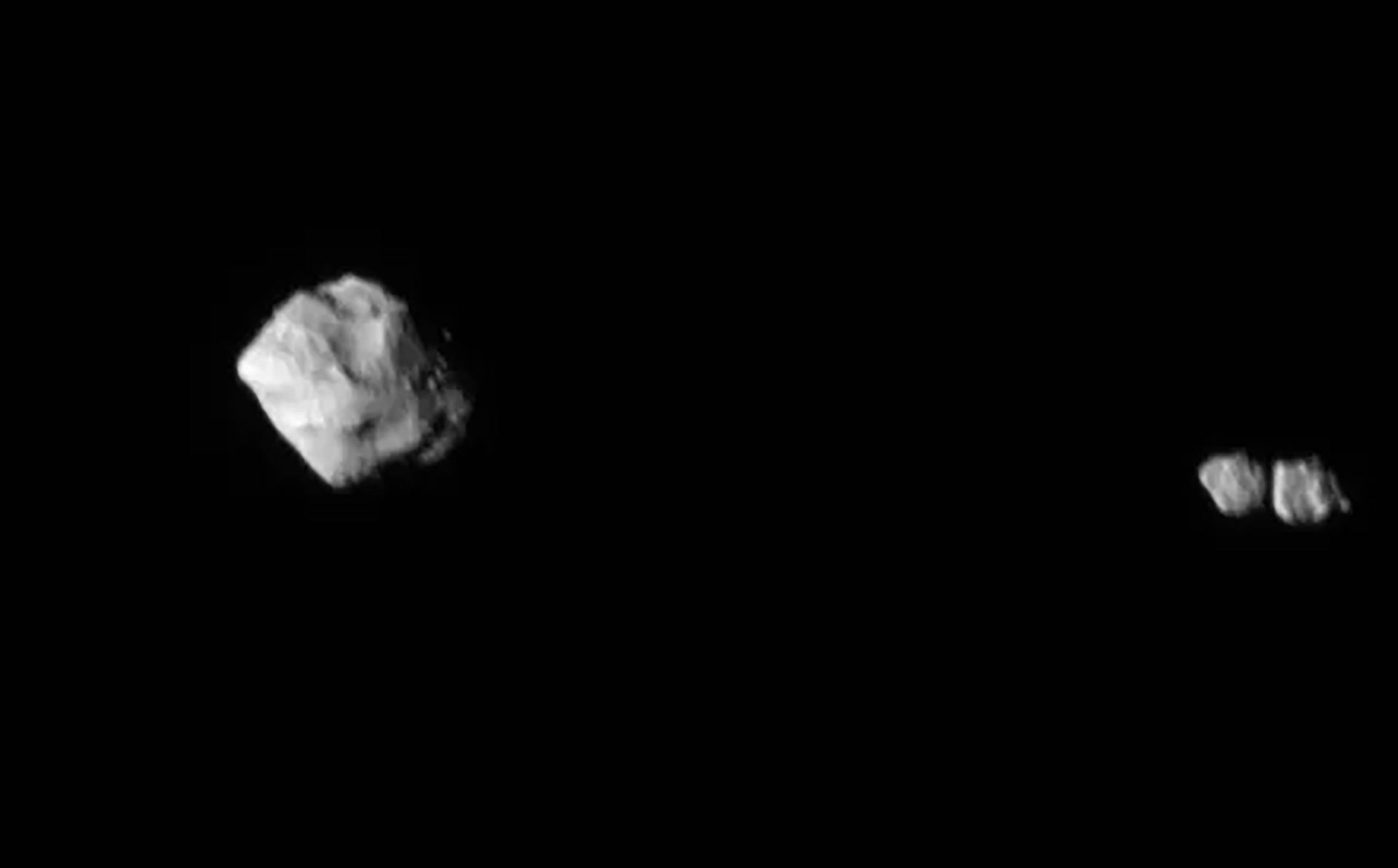A numerical model of the formation, at low velocity, of satellites in binary asteroid systems was Published on November 17th in the journal Icarus by a research team from IPGP and Université Paris Cité. This model, suggesting the existence of “contact binary” satellites, has just been validated by observations of the flyby of the binary asteroid Dinkinesh by NASA’s Lucy mission.

© NASA/Goddard/SwRI/Johns Hopkins APL
A significant fraction of the asteroids in our Solar System are binary objects, i.e. they consist of a main body and a satellite orbiting the main asteroid. The pairing of Ida (main body) and Dactyl (satellite), for example, was photographed by the Galileo probe back in 1994, and the formation of this type of object was generally explained by collisions between asteroids.
In recent years, new observations have revealed a new category of binary asteroids, whose main body is diamond-shaped, with a large equatorial protuberance. For these systems, current models explain the morphology of prolate (rugby ball-shaped) companion satellites by a rapid or instantaneous ejection of debris from the main asteroid leading to the rapid formation of the satellite.
However, close-range observation by NASA’s DART mission in 2022 of the Didymos (main body) and Dimorphos (satellite) pair (which will also be the target of the Hera mission carried out by ESA in 2026 under the scientific responsibility of researchers from CNRS and OCA1), shows that the system’s satellite does not have the expected prolate morphology.
Two researchers from the IPGP and Université Paris Cité have carried out a series of numerical experiments to propose a mechanism for the formation of this asteroid system, inspired by a model previously proposed for the formation of Saturn’s satellites.
In a paper published on 17 November in the journal Icarus, the two researchers suggest that the satellite could also have formed from a ring of debris ejected at low velocity by the main body. They propose that if the loss of material occurs over a longer period (of the order of a few years), a new satellite formation regime emerges – the ‘pyramidal regime’ – in which satellites are formed by low-velocity collisions of objects of similar size, the end result being the formation of a ‘binary contact’ satellite, if two proto-satellites remain stuck together, or an oblate satellite (in the shape of a flattened sphere) if two proto-satellites merge.
The latter oblate morphology corresponds to the shape observed for the Didymos/Dimorphos asteroid pair, whereas the contact binary morphology was purely theoretical until now.
But this morphology has just been validated in a timely fashion by NASA’s Lucy mission, on1 November, during the first flyby of the asteroid Dinkinesh. This first observation led to the discovery that Dinkinesh was, in fact, a binary asteroid. Even more astonishingly, the images also revealed that its satellite has a “contact binary” morphology, as predicted by the IPGP team.
This observation, the first ever for a contact binary satellite, could therefore indicate that Dinkinesh’s satellite formed over timescales of several years, from the mass gradually lost by the main body.
1- Hera is ESA’s first planetary defence mission. The scientific leaders of the mission are researchers from the CNRS and the Observatoire de la Côte d’Azur (OCA), working at the Lagrange laboratory (CNRS/OCA/Université Côte d’Azur).
Bibliography:
> Revisiting Dimorphos formation: A pyramidal regime perspective and application to Dinkinesh’s satellite, Gustavo Madeira, Sebastien Charnoz, Icarus, Vol. 409, 2024.
DOI: 10.1016/j.icarus.2023.115871
Read more
![[Circle U.] Fast Forward Open Science](https://u-paris.fr/wp-content/uploads/2025/09/CC.-OPEN-ACCESS-WEEK-1080x675.png)
[Circle U.] Fast Forward Open Science
On the 22nd of October from 1:30 to 4:30 pm, Circle U. will host the online event ‘Fast forward Open Science’, led by Université Paris Cité, as part of the International Open Access Week 2025. Experts in open access publishing, research data management, open source...
read more
No relationship between Université Paris Cité and the private company operating under the name City University of Paris
Université Paris Cité discovered that a private higher education establishment initially called Intelligest has recently changed its company name for ‘City University of Paris’. Université Paris Cité points out that it has no links whatsoever (association,...
read more
Results of the 2025 Call for Projects with the University of Toronto
The 2025 call for projects between Université Paris Cité and the University of Toronto met with great enthusiasm within the scientific communities of both institutions. Eighteen proposals were submitted by pairs of researchers; five projects were selected at the end...
read more
Call for projects 2025 UPCité – King’s College London
The call for projects between Université Paris Cité (UPCité) and our privileged partner King's College London (KCL), has been launched this friday, May 9th 2025. The objectives Université Paris Cité and King's College London are offering offering a seed funding for...
read more